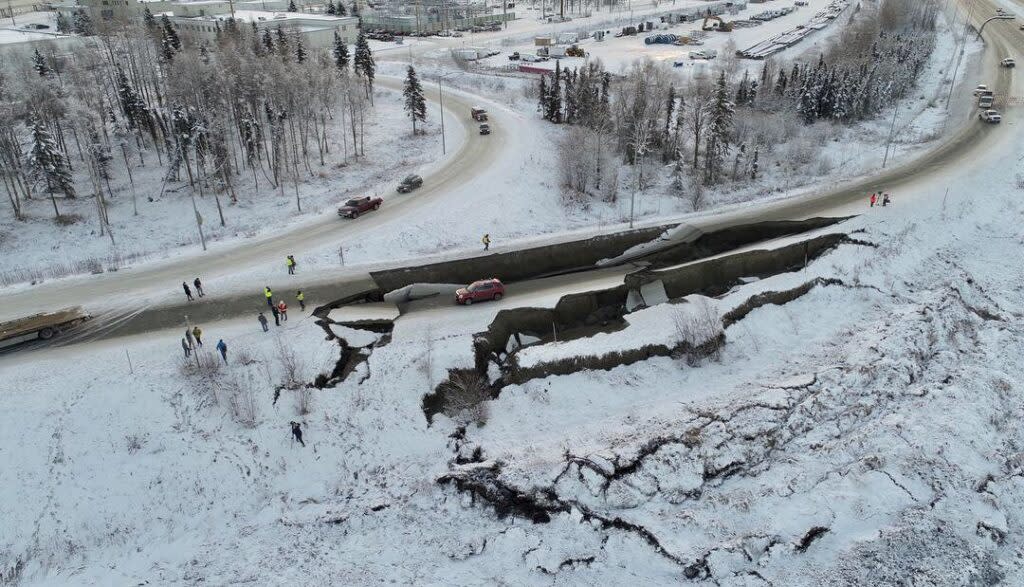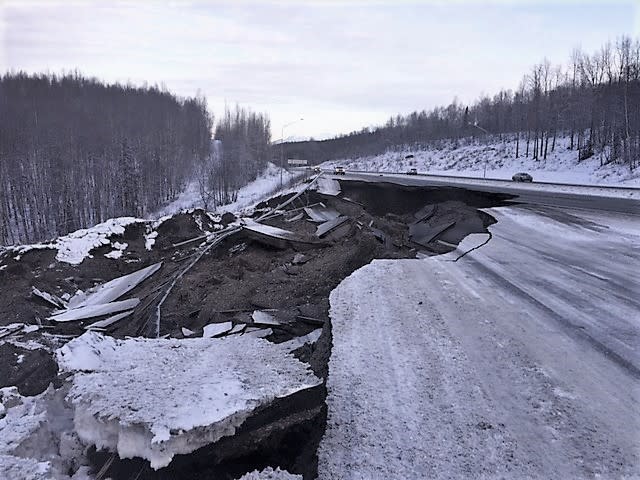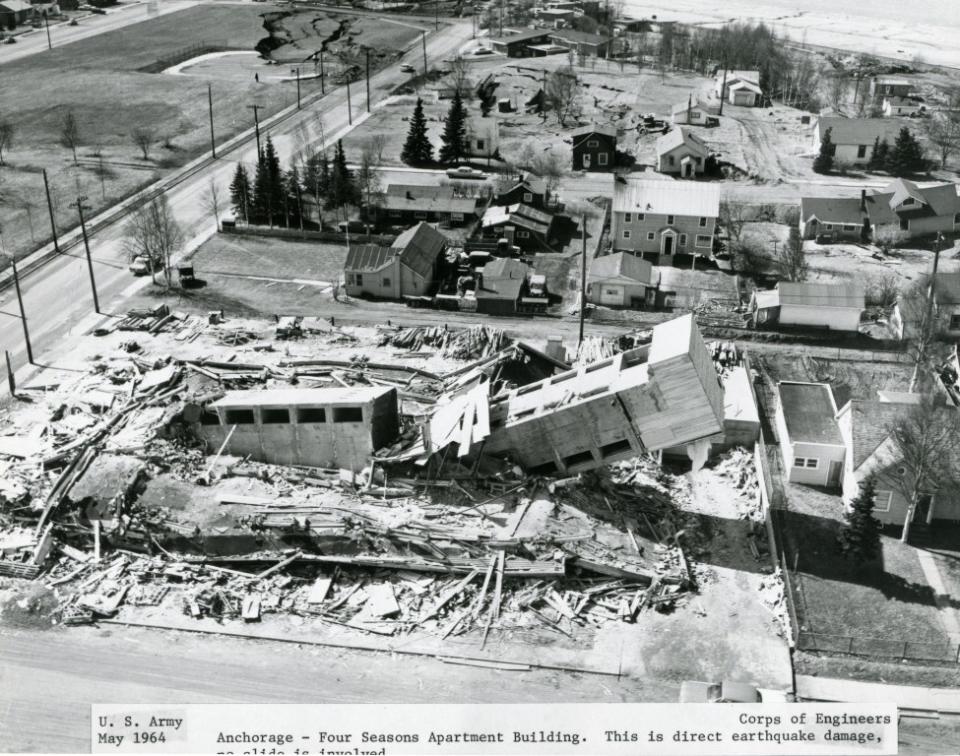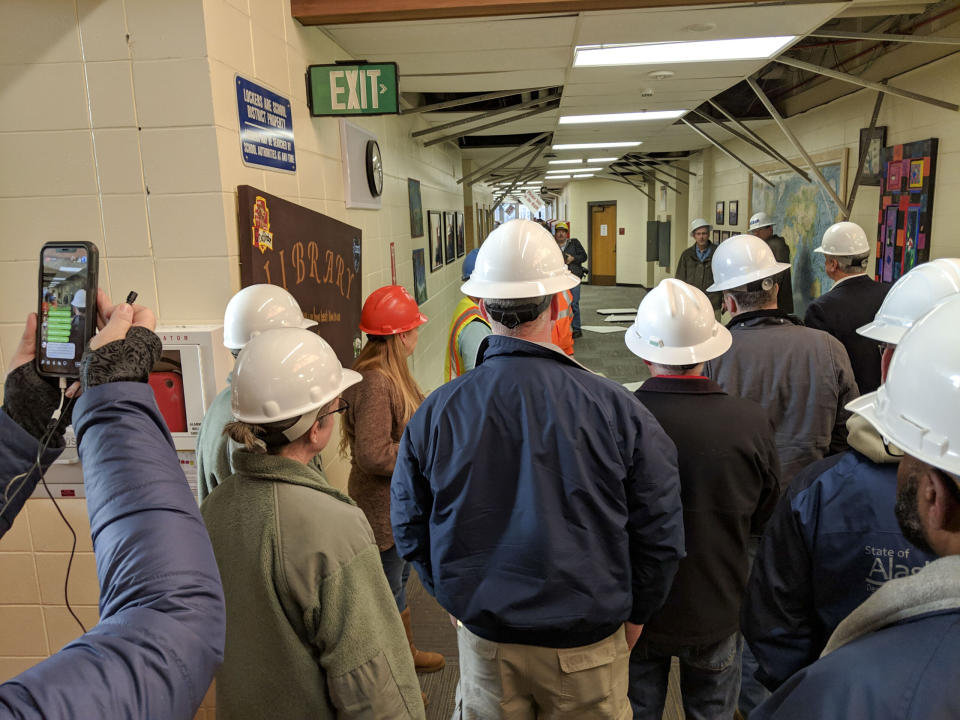In seismically active Alaska, plans for statewide residential building codes are on shaky ground

Damage to Anchorage's Minnesota Drive from 2018 earthquake is seen from the air. The 7.1-magnitude earthquake struck on Nov. 30 of that year. (Photo by Alaska Aerial Media provided by the Alaska Department of Transportation and Public Facilities)
Sixty years after North America’s most powerful earthquake on record ripped through Alaska and 5 ½ years after a different earthquake caused costly damage to structures and roads in the Southcentral region, there are no statewide codes to protect homes against future seismic disasters.
Two bills pending in the Alaska Legislature, Senate Bill 197 and House Bill 150, would create such statewide residential building codes. Both were introduced last year, but neither has made it to a floor vote. Both have run into headwinds at the committee level, to the frustration of supporters.
The magnitude 7.1 earthquake that hit the Anchorage area in 2018 “absolutely should have been” a wakeup call, said Barrett Salisbury, a state geologist who chairs the Alaska Seismic Hazards Safety Commission. The commission is charged by state law with making recommendations to the public and private sectors to mitigate the threats posed by earthquakes.
Salisbury pointed to the pattern of damage wrought by the 2018 quake that showed much better structural performance in the Anchorage Bowl, where there are enforced codes, than in outlying communities to the north, which lack those enforced codes.
“There is concrete evidence now that there are improvements that could be made. And I think some of those are reflected here in these bills. But the urgency that gets them passed, I think, is missing,” Salisbury said. “I personally feel like we run into that issue a lot with these types of hazards that are kind of few and far between but really impactful when they do occur.”
Some of the most compelling evidence to which Salisbury referred is in a 2021 University of Alaska Anchorage-led study that detailed worse building performance in the outlying communities of Eagle River and Chugiak, which do not have residential building codes despite being part of the Municipality of Anchorage, and in the Matanuska-Susitna Borough, which also lacks such codes. In those northern communities, rates of damage to buildings were 18 to 20 times as high as rates within the area of Anchorage where codes are mandated, the study said.
And of the 40 buildings in the Municipality of Anchorage that suffered severe damage in 2018, 38 were in areas without code enforcement, the Alaska Seismic Hazards Safety Commission has pointed out.
Despite Alaska’s experience with earthquakes, building code coverage around the state is uneven and enforcement is spotty. The state adopted strict building codes after the magnitude 9.2 Great Alaska Earthquake of 1964, but they do not apply to residential structures that are three-plexes or smaller, according to the Alaska Seismic Hazards Safety Commission. Some local governments, like Anchorage, have codes that cover residences and enforce them; other regions do not.

Earthquake damage is seen on the Glenn Highway near Mirror Lake on Nov. 30, 2018. That day, a magnitude 7.1 earthquake struck and caused widespread structural damage in Southcentral Alaska. (Photo provided by Alaska Department of Transportation and Public Facilities)
The 2018 earthquake should have been a convincing case in favor of statewide building codes, said Sen. Jesse Bjorkman, R-Nikiski, the sponsor of the Senate bill. But it apparently was not, he said.
“I think that’s the correct statement, that people don’t learn from history, and they are often doomed to repeat it,” said the senator, a former teacher.
Homebuilders, housing experts are supporters
Bjorkman said he introduced his bill in response to efforts by the Alaska Home Builders Association, which has pushed for statewide residential building codes for several years, and the Kenai Peninsula Builders Association.
That organizations’ representatives, in committee testimony and written messages, described building codes as a matter of professionalism and consumer protection, applicable to Alaska’s extreme weather conditions and home-heating needs as well as to seismic safety.
In addition to the homebuilders’ associations and the Alaska Seismic Hazards Safety Commission, the Cold Climate Housing Research Center at the University of Alaska Fairbanks supports the legislative effort.
Bjorkman characterizes his bill as modest. It simply “provides a legal backstop for folks that are making a cash purchase of a house that a contractor is building,” he said. “There are no building inspectors attached to this idea. There is no enforcement from the state. The only enforcement is in civil court.”
That falls short of what was recommended in the 2021 UAA-led study.
The study’s first recommendation is for enforcement of statewide standards through required inspections. “Immediate legislation is needed for a mandatory building permitting process, plan review, and construction inspection throughout Alaska,” applying to new construction and building upgrades and including all the communities and unincorporated areas outside of Anchorage’s current code-enforcement zone, the study said.
Even when codes exist, they are not always enforced, the study said. Within Anchorage, code enforcement was lax until the 1990s, and that showed in the earthquake results: Structures built prior to the 1990s fared worse than did more modern structures built at a time of consistent enforcement, the study found.
The idea of enforceable building codes is a fraught subject in some areas of the state.
An argument, articulated by Sen. Donny Olson, D-Golovin, is that statewide building codes would be unworkable in rural Alaska.

The wrecked Four Seasons Apartment Building in Anchorage is seen in the aftermath of the 1964 earthquake. At magnitude 9.2, it was the most powerful earthquake ever recorded in North America. The shaking and the resulting tsunami caused 131 deaths, according to federal officials. (U.S. Army Corps of Engineers photo provided by Joint Base Elmendorf-Richardson)
While the bill exempts owner-builders, it is unclear how it would treat people who, though not contractors, build homes for others, as happens in rural areas, he told Bjorkman at a March 6 Senate Finance Committee hearing.
“I’m thinking about my place in rural Alaska where you don’t have any contractors and you don’t have anybody to build. And you don’t necessarily want to build it yourself because it’s above your mental capabilities sometimes to go in and think of what the wind loads are going to be, what the snow loads are going to be and all those other issues that are out there,” Olson said.
Even if a licensed contractor is found and hired, compliance with codes could be costly, he said later in the hearing. “Let’s say a contractor’s building a house out on St. Lawrence Island, Savoonga, even out on Diomede. You’ve got to pay for the inspector to get out there. And then there’s a delay until he gets out there and inspects it,” he said.
Concerns about added costs, delays and other complications
Other skeptics have cited more philosophical opposition, such as that expressed by Rep. Mike Prax, R-Fairbanks, in a committee hearing held a year ago.
Prax, during that 2023 House Labor and Commerce Committee hearing, said his own experience and that of his neighbors in the Fairbanks North Star Borough indicates that a statewide building code is unnecessary and could be counterproductive. For his family’s home, “We read the national building codes and decided that wasn’t appropriate for Alaska, and we built beyond the code to meet our needs. So, one concern is the code provides or could provide a false sense of assurance that you’re getting a quality home, as compared to just knowing your contractor,” he said.
Additionally, banks in the Fairbanks North Star Borough already require homes to be built to a code, with inspection confirming that, before they grant any loans, and that system is working, he said.
One opponent of the effort, in written comments sent to the Senate Labor and Commerce Committee, characterized the idea as a costly Anchorage-centric imposition on the rest of the state.
“Please keep the state out of building codes and allow the borough and other regions to be flexible in building practices in their region. State interference will drive up the price of new construction, add construction delays while waiting for state inspectors, and lead to cost overruns,” said a message sent to the Senate Labor and Commerce Committee from Jennifer Sampson of Fairbanks.
Salisbury said there are some valid rural concerns. It is time-consuming to get multiple inspections done at different points in the construction process, he said. There may be a possibility for remote inspections through videos, or even rural exemptions, he said. “I think until that is a little more clearly defined, he’s probably right and that it’ll be onerous for those folks in the Bush to get these types of inspections complete,” he said.

Government officials, including Sen. Lisa Murkowski and Sen. Dan Sullivan, tour earthquake-damaged Houston Middle School on Dec. 8, 2018. The school building was so damaged from the magnitude 7.1 earthquake that struck days earlier that it had to be demolished and replaced. (Photo by Balinda O’Neal Dresel/U.S. Army National Guard)
But building codes can save money in the long run, Salisbury said. They help prevent costly damages, and they also make it more likely that the Federal Emergency Management Agency will fund retrofits to improve safety prior to disasters, he said.
The House bill remained in that body’s labor and commerce committee as of early April.
As for the Senate version, Bjorkman gives it little chance of moving beyond that body’s finance committee. He is unlikely to reintroduce it next year, he said.
“I’ll let somebody else carry the torch if they want to, but it’s not something that I’m interested in doing again because of the irrationality and impractical nature of the system,” he said.
Legislation to establish and enforce statewide residential building codes was not the only expert recommendation to come from the 2018 quake.
Other recommendations, as listed in the 2021 study, include identification and upgrades at vulnerable structures accessible to the public, even if privately owned, and for older homes and structures that may be out of compliance with modern codes. The Alaska Seismic Hazards Safety Commission has recommended creation of an information clearinghouse that lists vulnerable critical infrastructure and potential ways to make it more resilient, including sources of funding.
There has been little action on any of the recommendations, Salisbury said.
Along with its recommendations, the UAA-led study contains a warning: Even if their homes emerged unscathed in 2018, Anchorage residents should not be complacent about safety if a more powerful quake hits.
The shaking intensity that occurred was only about half as powerful as the level that is meant to be absorbed, according to a standard known as the design-based earthquake spectrum, or DBE, it said.
“The Nov. 2018 earthquake was not a sufficient test to assess the actual seismic vulnerability of Southcentral Alaska’s built environment. The level of structural damage observed does not necessarily imply high quality of construction or adherence to building codes since most buildings were not tested to the DBE,” the study said.
GET THE MORNING HEADLINES DELIVERED TO YOUR INBOX
The post In seismically active Alaska, plans for statewide residential building codes are on shaky ground appeared first on Alaska Beacon.

